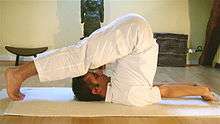Halasana
Halasana (/hʌˈlæsʌnʌ/;[1] Sanskrit: हलासन; IAST: Halāsana) or Plow Pose[2] is an asana.
Etymology
The name comes from the Sanskrit words hala (हला) meaning "plow" and asana (आसन) meaning "posture" or "seat".[3]
Description

The practitioner lies on the floor, lifts the legs, and then places them behind the head. Experienced practitioners may enter Halasana from a standing position by tucking chin to chest, placing hands on the floor, walking the feet towards the hands and bending at the elbows to lower shoulders to the floor.
Health Benefits
- Stretches all muscles and ligament in the practitioner's calves and thighs, resulting in greater leg flexibility
- Therapeutic for leg cramps
- Stimulates the practitioner's thyroid, parathyroid, throat, lungs and abdominal organs
- Helps relieve gas and upper/lower back pain or discomfort
- Promotes good digestion
- Stretches the practitioner's shoulders and spine
- Therapeutic for menopause, infertility, insomnia, headache and sinusitis
- Relieves stress and fatigue [4]
Cautions
This asana can put significant strain on the cervical spine, which does not normally undergo this type of stress, and can cause injury if not performed properly.[5][6][7]
Practicing this pose without leg support can lead to injury. To provide support for the legs, practitioners may elevate the feet on props such as blocks or on the seat of a chair instead placing the feet directly on the floor. As alternatives, simply lying on the back and raising the legs into a hamstring stretch, or doing a seated forward bend may be appropriate.
See also
References
- ↑ Budilovsky, Joan; Adamson, Eve (2000). The complete idiot's guide to yoga (2 ed.). Penguin. p. 175. ISBN 978-0-02-863970-3. Retrieved 11 April 2011.
- ↑ "Yoga Journal - Plow Pose". Retrieved 2011-04-09.
- ↑ Sivananda (Swami.) (June 1985). Health and hatha yoga. Divine Life Society. p. 128. ISBN 978-0-949027-03-0. Retrieved 9 April 2011.
- ↑ http://www.cnyhealingarts.com/2011/07/13/the-health-benefits-of-halasana-plow-pose/
- ↑ Active Interest Media, Inc. (February 1983). Yoga Journal. Active Interest Media, Inc. p. 7. ISSN 0191-0965. Retrieved 9 April 2011.
- ↑ Robin, Mel (May 2002). A Physiological Handbook for Teachers of Yogasana. Wheatmark, Inc. p. 516. ISBN 978-1-58736-033-6. Retrieved 9 April 2011.
- ↑ Robin, Mel (2009). A Handbook for Yogasana Teachers: The Incorporation of Neuroscience, Physiology, and Anatomy Into the Practice. Wheatmark, Inc. p. 835. ISBN 978-1-58736-708-3. Retrieved 9 April 2011.
Further reading
- Iyengar, B. K. S. (1 October 2005). Illustrated Light On Yoga. HarperCollins. ISBN 978-81-7223-606-9. Retrieved 9 April 2011.
- Saraswati, Swami Satyananda (1 August 2003). Asana Pranayama Mudra Bandha. Nesma Books India. ISBN 978-81-86336-14-4. Retrieved 9 April 2011.
- Saraswati, Swami Satyananda (January 2004). A Systematic Course in the Ancient Tantric Techniques of Yoga and Kriya. Nesma Books India. ISBN 978-81-85787-08-4. Retrieved 9 April 2011.